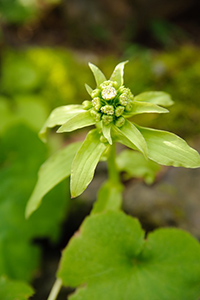Table of Contents
The butterbur plant is also known as significant coltsfoot due to the similar appearance of this plant to that of true coltsfoot, which is sometimes also called butterbur. Both plants have similar properties. Butterbur has been used in central Europe since the Middle Ages, though coltsfoot is preferred because it has a better flavor.
- Popular traditional herb
- Free of pyrrolizidine alkaloids (PA)
- Provides 7 mg of the sesquaterpene petasin per serving
- Per GMP guidelines set forth by the FDA, most products are formulated for 24 months from the date of manufacture. Liquids and probiotics are formulated for 12 months.

Healing Properties and Warning
The rhizome and the leaves of butterbur contain inulin, pectin, and mucilage, which give the plant its expectorant and emollient properties; glycosides and essential oil with antispasmodic, diuretic, sudorific, and emmenagogue properties; and tannin and resins, to which the plant owes its vulnerary properties. These are the principal applications of butterbur:
- Respiratory disorders: Its antispasmodic properties effectively prevent acute crises in bronchial asthma. It is also an antitussive and expectorant for bronchitis and bronchial pneumonia.
- Throat disorders: Butterbur is recommended for laryngitis, aphonia, and tracheitis.
- Anti-inflammatory: In external use, fresh butterbur leaves directly applied or mashed in poultices are recommended for phlebitis (inflammation of the veins), furuncles, and adenopathy (inflamed glands).

Warning! Butterbur contains variable amounts of alkaloids that may be toxic to the liver. Due to this, the German Commission E for Human Medicine phytotherapy section does not recommend its use, although it does not ban it.
Butterbur Plant Scientific Facts

- Other names: Major Coltsfoot.
- French: Petasite hybride.
- Spanish: Sombrerera.
- Environment: Wet soils and banks of rivers and brooks in warm and cold regions of Europe.
- Description: Vivacious plant of the Compositae family, growing up to 50 cm high. In the early Spring, some flower stems grow from the underground rhizome, with pink or violet flower heads. Its large, petioled leaves grow later.
- Parts of the plant used medicinally: The rhizome and the leaves.
How to use Butterbur
- Infusion with 20-30 g of leaves and/or rhizome per liter of water, drinking from three to five cups daily.
- Poultices with fresh mashed leaves.
Frequently Asked Question
I’ve heard about butterbur plant for migraines, but what’s the science behind it?
Scientific studies suggest that butterbur may reduce inflammation and constrict blood vessels in the brain, which are factors in migraine headaches. Additionally, butterbur might block chemicals in the brain that contribute to migraines.
Is the butterbur plant safe for children with migraines?
Evidence suggests butterbur may be safe and effective for children with migraines when used for short periods (up to 4 months). It is essential to consult your pediatrician before giving butterbur to a child.
Are there specific forms of the butterbur plant that are better than others?
Look for butterbur products labeled “PA-free” or “certified pyrrolizidine alkaloid-free.” Unprocessed butterbur contains pyrrolizidine alkaloids (PAs) that are toxic to the liver. Reputable brands remove these compounds during manufacturing.
Can the butterbur plant help with allergies (hay fever) and migraines?
Studies have shown mixed results. Some research suggests butterbur can reduce allergy symptoms like itchy eyes, runny nose, and congestion. However, other studies have not found strong support for its effectiveness against hay fever.
I’m taking prescription medications. Could butterbur interact with them?
Always consult your doctor before using butterbur. It may interact with certain medications, such as medications broken down by the liver. Your physician can evaluate your condition and advise you on the safety of butterbur.
I have asthma. Can butterbur help with that?
Unfortunately, there is insufficient scientific evidence to conclude that butterbur benefits asthma. However, some people swear by the plant’s ability to treat asthma symptoms.
What are the typical side effects of butterbur?
PA-free butterbur is generally well-tolerated in the short term. Possible side effects include headache, fatigue, drowsiness, diarrhea, nausea, and belching.
Where can I find reliable butterbur supplements?
Your primary focus should be “PA-free” products produced by reputable companies. These products are available online, in health food stores and in pharmacies. It is advisable to consult with your physician before commencing a new supplement regimen.
Are there any situations where I absolutely should NOT use butterbur?
Yes. Do not use butterbur if you are pregnant or breastfeeding, have liver disease, or are allergic to ragweed, daisies, or similar plants.
DISCLAIMER: All content on this website is presented solely for educational and informational objectives. Do not rely on the information provided as a replacement for advice, diagnosis, or treatment from a qualified medical expert. If you are pregnant, nursing, or have any preexisting medical concerns, talk to your doctor before using any herbal or natural medicines.
REFERENCES
- George D. Pamplona-Roger, M.D. “Encyclopedia of Medicinal Plants.” George D. Pamplona-Roger, M.D. Encyclopedia of Medicinal Plants. Ed. Francesc X. Gelabert. Vols. 1 San Fernando de Henares: Editorial Safeliz, 2000. 320. Print. [butterbur plant]
- Mayo Clinic: https://www.webmd.com/vitamins/ai/ingredientmono-649/butterbur
- National Center for Complementary & Integrative Health (NCCIH): https://www.nccih.nih.gov/health/butterbur
- Memorial Sloan Kettering Cancer Center: https://www.mskcc.org/cancer-care/integrative-medicine/herbs/butterbur
- Verywell Health: https://www.verywellhealth.com/is-butterbur-safe-for-migraines-1719847
Last update on 2024-07-23 / Affiliate links / Images from Amazon Product Advertising API






